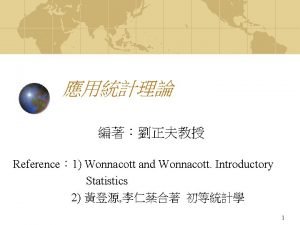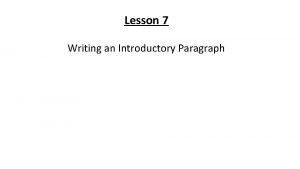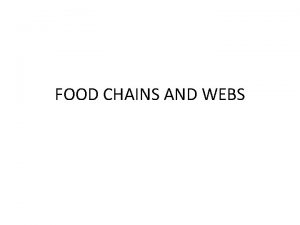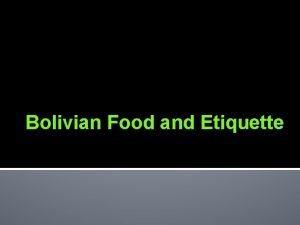FOOD AND CULTURE Culture and Foodways Introductory Lesson



















- Slides: 19

FOOD AND CULTURE Culture and Foodways – Introductory Lesson By Ms. Clarkson, 2013

WHAT IS CULTURE? • Culture is the customs and beliefs of a social, religious or ethnic group. • It involves the beliefs and behaviours of a specific group. • Culture is influenced by many different things including country of origin, religion, folklore, holidays, family, friends, media, arts, traditions, availability of food due to climate and land use, government, economy and technology. • A key component of culture is food! • Some cultures are more easily identified than others. Many Canadians struggle when we are asked to define our culture, whereas it is easy for us to identify patterns from other cultures.

COMPONENTS OF CULTURE

DEFINING CANADIAN CULTURE • http: //www. youtube. com/watch? v=BRI-A 3 vak. Vg • What stereotypes about Canadians are raised by Joe? • On the next slide is a list of what is important to Canada according to the Passports that we are issued. • Do you agree with the moments, items, people or places that were chosen to represent our Canadian heritage? Look up any that you are unfamiliar with. • What would you add or take away to make a more accurate representation?

• • • DEFINING CANADIAN CULTURE CONTINUED Inukshuks Samuel de Champlain The Fathers Of Confederation The Last Spike (in the national railroad) Extreme North Exploration Expeditions The Prairies Pier 21, Halifax The Parliament Buildings in Ottawa Niagara Falls Canadian National Vimy Ridge Memorial • • • Old Quebec City Royal Canadian Mounted Police The Grey Cup The Stanley Cup Nelly Mc. Clung Terry Fox Billy Bishop National War Memorial The Bluenose Cape Spear, Newfoundland

CULTURAL EXPERIENCES

FOOD IS CULTURE! • Watch this video to see how important food is to us! • http: //www. youtube. com/watch? v=a 1 d. Qly. NVp. TI#at=94

WHAT KEY POINTS WERE RAISED IN THE VIDEO?

MORE INTERESTING IDEAS ON HOW FOOD IS CULTURE • EVERYTHING has to do with food! • The capture, cultivation (growing), preparation and consumption of food have led to our cultural development. • E. g. The “choices” made by primitive humans were dictated by availability (economics) and medicinal properties (digestibility and nutrition) that led to specific social structures and traditions. • E. g. The “invention” of cooking allowed us to transform natural, edible objects into cuisine. Cooking led to kitchens. Raw materials (rocks, sticks, etc. ) became cooking tools. The birth of oral and written cooking guidelines led to specific cooking techniques. • The transmission of recipes allowed food to develop its own language and grow into a complex cultural product shaped by climate, geography, pursuit of pleasure and later, the desire for health. • Many “foodies” today owe thanks to our ancestors! In some cultures, food is even considered an “art” today.

OUR FOOD CHOICES ARE INFLUENCED BY… Cultural Factors Social / Psychological Factors • • Family • Lifestyle • Country of Origin Food Supply Factors • Flavours and Spices Available • Rural / Urban Environment Eating Patterns • Climate, Weather • Money and Time Available • Geography, Landscape • Economy • Trading Partners • Agriculture • Religion • Holidays • Celebrations • Friends • Traditions • Advertising • Folklore • Media • Ethnic Group • Food Fads and Fallacies • Food Taboos / Limitations • Health • Government • Convenience • Preferred Ingredients • Technology • Mood, Thoughts, Feelings • Education • • Availability / Seasonality Memories • Body Image • Food Safety • Skills, Equipment Available

WHAT FACTORS COULD BE INVOLVED IN THE FOOD CHOICES BEING MADE ABOVE?

FOODWAYS, AVAILABILITY AND ACCEPTABILITY ARE IMPORTANT PARTS OF CULTURE… • FOODWAYS is about the way we eat based on a combination of personal, societal and cultural influences. • A society’s foodways determine: • • • How food is acquired Which foods are consumed How foods are prepared Who prepares the food Who eats the food and with whom When foods are eaten, and in what quantity Q: How would you describe the FOODWAYS you observe here in Canada? • Foodways can change over time, depending on exposure to foreign cultures, economic development, or under the guidance of health experts or government initiatives.

AVAILABILITY AND ACCEPTABILITY • Availability of food is determined by biological and climatic factors in addition to the nature of production, marketing and distribution of food (economic factors) • Acceptability of food depends on personal and cultural associations. • E. g. Poor farmers who grow bananas for export but have no land to use to grow food to feed themselves. • For example, many of us turn up our noses at eating horse meat, dog meat, or insects, although in other parts of the world, these foods are widely eaten because they are nutritious. Q: What foods are not acceptable to you for eating? Why not? • Personal preference and associations also determine our own “acceptability” of food. Something may remind us of happy times and we choose to eat it, whereas something else may have negative associations, so we avoid it.

WOULD YOU EAT THAT?

DEFINITION OF CUISINE A CUISINE is defined as… Cooking traditions, practices, and food and beverages associated with a particular region; everything concerned with eating, including the resources, technology and taste preferences involved. In the past, cuisine was influenced by the availability of food and religion. Improvements in food distribution allowed cuisines to influence each other (a. k. a. globalization of food).

COMPONENTS OF CUISINE • Foods Chosen • What’s available and the nutrient content compared to the energy required to obtain them. • Cultural Rules • The number of meals eaten each day; who the meals are eaten with; special uses of foods, observation of food taboos (forbidden foods). • Manner of Preparation • The variety of ways that food can be prepared, including cooking methods and equipment • Flavouring Principles • The use of various herbs and spices used to flavour staple foods (main foods that make up most main dishes in the cuisine).

WHAT’S A STAPLE FOOD? • Cuisines are based on staple foods which are typically grains or roots that are readily available, fairly inexpensive, and provide a significant amount of carbohydrate, fat and protein to the people of the area. They vary from region to region. Sometimes staple foods may be animal products as well. • Many “spin off” products can be made from staple foods. E. g. tortillas • Examples of staple foods include corn (maize), rice, wheat, millet, sorghum, potatoes, cassava, yams, taro, quinoa and pulses (beans, peas and lentils).

KEY CONCEPTS TO REMEMBER • Culture • Factors Affecting Food Choices • Foodways • Acceptability • Cuisine • Components of Cuisine • Staple Food

FOOD MEMORY ASSIGNMENT: HOMEWORK TASK • Write a 2 -3 paragraph description of a food memory that is significant to you. • This could be a memory of a significant event in your life that involved food, an incident where you discovered that you liked or disliked a food, a description of the first time that you tried a food, or a description of the best thing you ever ate. • Include the following points: • • • What was the situation? Where were you? Who was involved? What foods were involved? What senses (sight, taste, texture, sound, appearance) were involved in your experience, and how did this sensory experience affect your impression of the food? • Explain why this incident features so prominently in your memory.
 Unit 1 introductory lesson 1- variables and expressions
Unit 1 introductory lesson 1- variables and expressions What is a numerical expression
What is a numerical expression Unit 2 food food food
Unit 2 food food food Food chain sequence
Food chain sequence Introductory and concluding paragraphs
Introductory and concluding paragraphs Using therefore in middle of sentence
Using therefore in middle of sentence Comma after introductory phrase
Comma after introductory phrase Wonnacott and wonnacott introductory statistics pdf
Wonnacott and wonnacott introductory statistics pdf Introductory chemistry concepts and critical thinking
Introductory chemistry concepts and critical thinking Introductory words and phrases signals
Introductory words and phrases signals Introductory paragraph format
Introductory paragraph format Must not sentences examples
Must not sentences examples Keeping your hands clean and dry essay
Keeping your hands clean and dry essay It is an introductory section of a news story
It is an introductory section of a news story What is a paragraph hook
What is a paragraph hook Good introduction paragraph examples
Good introduction paragraph examples Adverbial clause reduction
Adverbial clause reduction Atlas ti7
Atlas ti7 Introductory paragraph format
Introductory paragraph format Introductory adverbial clauses
Introductory adverbial clauses





































